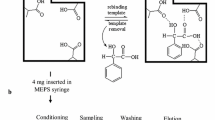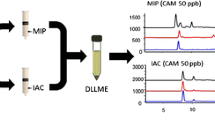Abstract
We describe a simple, environmentally friendly and selective technique for the determination of ochratoxin A (OTA) in urine. It involves (a) the use of a molecularly imprinted polymer as a sorbent in micro-solid-phase extraction in which the sorbent is contained in a propylene membrane envelope, and (b) separation and detection by capillary electrophoresis (CE). Under optimized conditions, response is linear in the range between 50 and 300 ng mL−1 (with a correlation coefficient of 0.9989), relative standard deviations range from 4 to 8 %, the detection limit for OTA in urine is 11.2 ng mL−1 (with a quantification limits of 32.5 ng mL−1) which is lower than those of previously reported methods for solid-phase extraction combined with CE. The recoveries of OTA from urine spiked at levels of 50, 150 and 300 ng mL−1 ranged from 93 to 97 %.

ᅟ




Similar content being viewed by others
References
Commission Regulation (EC) (2010) 105/2010 of 5 February 2010 amending Regulation (EC) No 1881/2006 setting maximum levels for certain contaminants in foodstuffs as regards ochratoxin A. Off. J. Eur. Communities, L 35/7
Mally A, Dekant W (2009) Mycotoxins and the kidney: modes of action for renal tumor formation by ochratoxin A in rodents. Mol Nutr Food Res 53(4):467–478
EFSA (European Food Safety Authority) (2004) Opinion of the scientific panel on contaminants in the food Chain on a request from the commission related to ochratoxin A (OTA) as undesirable substance in animal feed. Adopted on 22 September 2004. EFSA J 101:1
Manique R, Pena A, Lino CM, Moltó JC, Mañes J (2008) Ochratoxin A in the morning and afternoon portions of urine from Coimbra and Valencian populations. Toxicon 51(7):1281–1287
Walker R, Larsen JC (2005) Ochratoxin A: previous risk assessments and issues arising. Food Addit Contam 22(suppl 1):6–9
Pfohl-Leszkowicz A, Petkova-Bocharova T, Chernozemsky IN, Castegnaro M (2002) Balkan endemic nephropathy and associated urinary tract tumours: a review on aetiological causes and the potential role of mycotoxins. Food Addit Contam 19(3):282–302
IARC (1993) Monograph on the Evaluation of Carcinogenic Risks to Humans, Some Naturally Occurring Substances: Food Items and Constituents, Heterocyclic Aromatic Amines and Mycotoxins; International Agency for Research on Cancer, Lyon, France, vol. 56, p 489
Duarte SC, Pena A, Lino CM (2011) Human ochratoxin A biomarkers-from exposure to effect. Crit Rev Toxicol 41(3):187–212
Akdemir C, Ulker OC, Basaran A, Ozkaya S, Karakaya A (2010) Estimation of ochratoxin A in some Turkish populations: an analysis in urine as a simple, sensitive and reliable biomarker. Food Chem Toxicol 48(3):877–882
Vatinno R, Vuckovic D, Zambonin CG, Pawliszyn J (2008) Automated high-throughput method using solid-phase microextraction-liquid chromatography-tandem mass spectrometry for the determination of ochratoxin A in human urine. J Chromatogr A 1201(2):215–221
Afsah-Hejri L, Jinap S, Mirhosseini H (2012) Ochratoxin A quantification: newly developed HPLC conditions. Food Control 23(1):113–119
Paiga P, Morais S, Oliva-Teles T, Correia M, Delerue-Matos C, Duarte SC, Pena A, Lino CM (2012) Extraction of Ochratoxin A in bread samples by the QuEChERS methodology. Food Chem 135(4):2522–2528
Corneli S, Maragos CM (1998) Capillary electrophoresis with laser-induced fluorescence: method for the mycotoxin Ochratoxin A. J Agric Food Chem 46(8):3162–3165
Köller G, Rolle-Kampczyk U, Lehmann I, Popp P, Herbarth O (2004) Determination of Ochratoxin A in small volumes of human blood serum. J Chromatogr B 804(2):313–317
Köller G, Rolle-Kampczyk U, Lehmann I, Popp P, Herbarth O (2006) Comparison of ELISA and capillary electrophoresis with laser-induced fluorescence detection in the analysis of Ochratoxin A in low volumes of human blood serum. J Chromatogr B 840(2):94–98
Almeda S, Arce L, Benavente F, Sanz-Nebot V, Barbosa J, Valcárcel M (2009) Comparison of off- and in-line solid-phase extraction for enhancing sensitivity in capillary electrophoresis using ochratoxin as a model compound. Anal Bioanal Chem 394(2):609–615
Almeda S, Arce L, Valcárcel M (2008) Combined use of supported liquid membrane and solid-phase extraction to enhance selectivity and sensitivity in capillary electrophoresis for the determination of ochratoxin A in wine. Electrophoresis 29(7):1573–1581
Saito K, Ikeuchi R, Kataoka H (2012) Determination of ochratoxins in nuts and grain samples by in-tube solid-phase microextraction coupled with liquid chromatography-mass spectrometry. J Chromatogr A 1220:1–6
Romero-González R, Frenich AG, Vidal JLM, Aguilera-Luiz MM (2011) Determination of ochratoxin A and T-2 toxin in alcoholic beverages by hollow fiber liquid phase microextraction and ultra high-pressure liquid chromatography coupled to tandem mass spectrometry. Talanta 82(1):171–176
González-Peñas E, Leache C, Viscarret M, Pérez de Obanos A, Araguás C, López de Cerain A (2004) Determination of ochratoxin A in wine using liquid-phase microextraction combined with liquid chromatography with fluorescence detection. J Chromatogr A 1025(2):163–168
Campone L, Piccinelli A, Rastrelli L (2011) Dispersive liquid-liquid microextraction combined with high-performance liquid chromatography-tandem mass spectrometry for the identification and the accurate quantification by isotope dilution assay of Ochratoxin A in wine samples. Anal Bioanal Chem 399(3):1279–1286
Basheer C, Wong W, Makahleh A, Tameem AA, Salhin A, Saad B, Lee HK (2011) Hydrazone-based ligands for micro-solid phase extraction-high performance liquid chromatographic determination of biogenic amines in orange juice. J Chromatogr A 1218(28):4332–4339
Kanimozhi S, Basheer C, Narasimhan K, Liu L, Koh S, Xue F, Choolani M, Lee HK (2010) Application of porous membrane protected micro-solid-phase-extraction combined with gas chromatography–mass spectrometry for the determination of estrogens in ovarian cyst fluid samples. Anal Chim Acta 687(1):56–60
Feng Q, Zhao L, Lin JM (2009) Molecularly imprinted polymer as micro-solid phase extraction combined with high performance liquid chromatography to determine phenolic compounds in environmental water samples. Anal Chim Acta 650(1):70–76
Maier NM, Buttinger G, Welhartizki S, Gavioli E, Lindner W (2004) Molecularly imprinted polymer-assisted sample clean-up of ochratoxin a from red wine: Merits and limitations. J Chromatogr B 804(1):103–111
Lee TP, Saad B, Khayoon WS, Salleh B (2012) Molecularly imprinted polymer as sorbent in micro-solid phase extraction of ochratoxin A in coffee, grape juice and urine. Talanta 88:129–135
González-Peñas E, Leache C, López De Cerain A, Lizarraga E (2006) Comparison between capillary electrophoresis and HPLC-FL for ochratoxin A quantification in wine. Food Chem 97(2):349–354
Acknowledgments
Financial support of the work by a Universiti Sains Malaysia (USM) Postgraduate Research Grant Scheme (USM-RU-PRGS), 1001/PKIMIA/843052 and USM Research Fellowship Program is gratefully acknowledged.
Author information
Authors and Affiliations
Corresponding author
Rights and permissions
About this article
Cite this article
Lee, T.P., Saad, B., Salleh, B. et al. Micro-solid phase extraction of ochratoxin A, and its determination in urine using capillary electrophoresis. Microchim Acta 180, 1149–1156 (2013). https://doi.org/10.1007/s00604-013-1042-3
Received:
Accepted:
Published:
Issue Date:
DOI: https://doi.org/10.1007/s00604-013-1042-3




